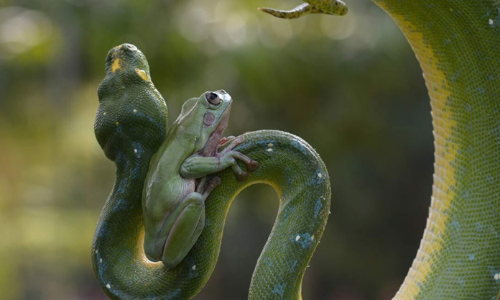Live
- Hyderabad Student Aryan Reddy Dies in Tragic Gun Misfire Accident on His Birthday in Atlanta
- Iraqi PM, Putin discuss regional situation, energy cooperation over phone
- Pushpa 2 Shooting Still Pending? Will It Release on Time?
- Can air pollution affect weight gain and hormonal health?
- Vishvaraj Singh Mewar's coronation ceremony in Chittorgarh on Nov 25
- KL Rahul’s Controversial Dismissal Sparks Debate in 1st Test at Perth
- Cricket Australia to honour late Philip Hughes on 10th anniversary
- Khushi Kapoor shines bright
- Suhana Khan’s power dressing game is inspiring
- Disha Patani sets the internet ablaze
Just In

How do you tell the difference between a reptile and an amphibian To help your young children understand the similarities and differences between reptiles and amphibians, make a chart For older elementary and junior high kids, let them create charts listing differences between different kinds of reptiles or amphibians eg, how is a frog different from a salamander
How do you tell the difference between a reptile and an amphibian? To help your young children understand the similarities and differences between reptiles and amphibians, make a chart. For older elementary and junior high kids, let them create charts listing differences between different kinds of reptiles or amphibians (e.g., how is a frog different from a salamander?).
Since reptiles and amphibians can be hard to observe in the wild, take a field trip to a zoo or pet store. You might call ahead to see if your kids will be allowed to handle any of the animals. Before you go, ask younger kids what they think a snake feels like. What about a frog? A turtle? Will a frog or a snake feel more ‘slimy’? After the visit, discuss the experience. Encourage older kids to investigate feeding habits, make sketches, observe how the animal moves, etc.
If you are handling frogs in the wild, be sure that you have wet hands or hold the animal with a plastic bag. Your bare hands can quickly cause the frog’s skin to dry out. After touching any amphibian or reptile, be sure to wash your hands well with soap and water!
To find out more about frogs, do research on one of these topics: what kinds of frogs live in your area? Can you find more than one species of tadpole locally? If so, compare them. What do local frogs eat? How would the mosquito population be affected if there were few or no frogs in a swampy region? Pick a frog or frog characteristic that is interesting to you, and see what you can find out about it. Look for close-up frog pictures in a magazine like National Geographic or on a website.
Comparing Frogs & Snakes To see for yourself how an amphibian and reptile differ, examine the external anatomy of two species such as a frog and a snake. You can observe the external anatomy of live ones at a pet store. Or do an online image search: try ‘bufo’ (part of the scientific name for some frog species), ‘bullfrog,’ ‘poison dart frog,’ ‘tree frog,’ ‘garter snake,’ ‘elipidae’ (the main family of poisonous snakes), ‘colubridae’ (the family with common snakes), and ‘boidae’ (constrictors).
This is just an overview of some features of frogs and snakes – there’s a lot more to learn about them! Skin & scales: How does the skin of a frog look (and feel) compared to a snake or other reptile? One is typically smooth and moist, one is dry and scaly. Frogs can exchange oxygen and carbon dioxide through their skin. They have mucous glands that secrete a waterproof coating to keep their skin moist and slippery.
Snakes have a tough coating of scales made of keratin, the same protein that forms your hair and fingernails. Each species either has smooth scales or rougher keeled ones, with a unique pattern of scales and coloring. They also have long horizontal scales on their belly that help them move across surfaces.

© 2024 Hyderabad Media House Limited/The Hans India. All rights reserved. Powered by hocalwire.com







